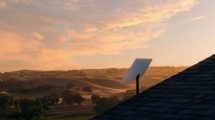
Image credit:
Image of Algeria acquired by UK-DMC2 satellite © DMCii, 2013.
DMC International Imaging (DMCii) is reportedly helping The Algerian Space Agency (ASAL) to predict the spread of locust plagues across North Africa using satellite imagery.
The imagery, from the UK-DMC2 satellite, is used in conjunction with weather data to help create locust forecasts and focus the application of pesticides to prevent the spread of swarms
Every year, North Africa is subjected to locust plagues that threaten to decimate crops and endanger countries’ food security. The satellite imagery is used to assess vegetation conditions, which helps to predict the locations of locust breeding grounds. The imagery, from the UK-DMC2 satellite, is used in conjunction with weather data to help create locust forecasts and focus the application of pesticides to prevent the spread of swarms.
In 2012, in a six-month summer campaign to fight the spread of locusts, DMCii acquired monthly images of regions in Southern Algeria, Northern Mali and Northern Niger for ASAL. Now, imagery is being acquired before the summer season starts, to predict as well as monitor the threat of locusts.
Karim Houari, International Cooperation Director of the Algerian Space Agency commented: “The use of satellite imagery has helped us in the past, during the invasion period, to identify and control areas at risk of locust swarms. This year, in terms of locust risk prediction in remission period, we used DMCii data for the ecological assessment of locust breeding areas (biotopes). It is an important contribution for the rationalisation of local response and to reduce damage of this destructive phenomenon.”
Paul Stephens, Director of Sales and Marketing at DMCii, said: “The ability to get timely imagery of large areas is vital because locust swarms can develop quickly and travel about 100 kms a day. Our 650 kms-wide images allow large areas of land, spanning multiple countries, to be rapidly monitored, helping the local authorities combat locust swarms before they can migrate across the continent.”














Add Comment